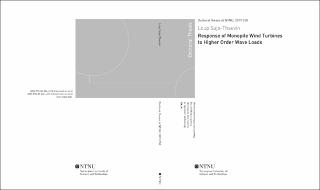| dc.contributor.advisor | Krokstad, Jørgen | |
| dc.contributor.advisor | Amdahl, Jørgen | |
| dc.contributor.author | Suja-Thauvin, Loup | |
| dc.date.accessioned | 2020-02-14T08:54:44Z | |
| dc.date.available | 2020-02-14T08:54:44Z | |
| dc.date.issued | 2019 | |
| dc.identifier.isbn | 978-82-326-4113-0 | |
| dc.identifier.issn | 1503-8181 | |
| dc.identifier.uri | http://hdl.handle.net/11250/2641679 | |
| dc.description.abstract | Monopile bottom-fixed offshore wind turbines have been in operation for around 30 years, and more are being planned for the next decades. The location and wave conditions of the planned wind farms make them susceptible to encounter steep and /or breaking waves during extreme weather events, typically storms with a return period of 50 years. These waves can produce large dynamic responses that threaten the structural integrity of the turbine. It is therefore necessary to accurately model the loads produced by these steep waves and the responses of the structure during the design stage of offshore wind turbines.
In this thesis, measurements from three experimental campaigns with model-scale wind turbines subjected to extreme sea states are presented. In all three campaigns, the largest responses were measured when a steep and breaking wave was passing through the turbine. The response was a combination of a ringing type of response (i.e. transient excitation of the first eigenmode of the structure) and excitation of the second mode of the structure. Ringing responses were attributed to second and third order hydrodynamic loads, while second mode response was triggered by so-called slamming loads (i.e. impulse loads produced by a wave breaking at the cylinder). The response was decomposed and for extreme events, quasi-static response accounted for 40 to 50% of the total response, the first mode accounted for 30 to 40% and the second mode for up to 20%. Higher modes were not analyzed.
Three design standards typically used for wind turbines in the North Sea were followed in this thesis. Different models suggested in the standards were implemented to simulate the responses measured during the experimental campaigns. Consistently with previous research, it was found that models that did not include non-linear kinematics did not match the measured first mode response, and models that did not include slamming loads did not produce significant second mode response. One of the commonly used models, the Morison equation with stream function wave kinematics and Wienke’s slamming load model, was found to have the capability of exciting both the first and second mode of the turbine, but generally missed the balance between the contribution of these two modes.
The model recently developed by Kristiansen and Faltinsen (2017), hereafter referred to as KF was implemented for irregular waves, and it was found that this model has the capability to produce ringing responses, but generally overestimates the first mode response for very steep waves. The Rainey model, which in the present implementation only differs from the KF model in their respective point loads, produced responses very similar to those calculated with the KF model. This was shown to be due to the point loads producing similar forces for steep waves.
The original contributions of this work to the offshore wind research community include the quantification of the contributions of different eigenmodes in the response to steep and breaking waves, the assessment of different hydrodynamic load models compared to experimental results, and a suggestion for the implementation of the KF model in irregular waves with fully non-linear kinematics. | |
| dc.language.iso | eng | nb_NO |
| dc.publisher | NTNU | nb_NO |
| dc.relation.ispartofseries | Doctoral theses at NTNU;2019:258 | |
| dc.relation.haspart | Paper 1:
Suja-Thauvin, Loup; Krokstad, Jørgen R; Frimann-Dahl, Joakim Fürst.
Maximum Loads on a One Degree of Freedom Model-scale Offshore Wind Turbine. Energy Procedia 2016 ;Volum 94. s. 329-338
https://doi.org/10.1016/j.egypro.2016.09.191
This is an open access article under the CC BY-NC-ND license | |
| dc.relation.haspart | Paper 2:
Suja-Thauvin, Loup; Krokstad, Jørgen R.
Simplified Bottom Fixed Offshore Wind Turbine in Extreme Sea States.
Proceedings of the Twenty-sixth (2016) International Ocean and Polar Engineering Conference. | |
| dc.relation.haspart | Paper 3:
Suja-Thauvin, Loup; Krokstad, Jørgen R; Bachynski, Erin Elizabeth; de Ridder, Erik-Jan.
Experimental results of a multimode monopile offshore wind turbine support structure subjected to steep and breaking irregular waves. Ocean Engineering 2017 ;Volum 146. s. 339-351
https://doi.org/10.1016/j.oceaneng.2017.09.024 | |
| dc.relation.haspart | Paper 4:
Suja-Thauvin, Loup; Krokstad, Jørgen R; Bachynski, Erin E.
Critical assessment of non-linear hydrodynamic load
models for a fully flexible monopile offshore wind turbine.
Journal of Ocean Engineering, vol 164, p 87-104, 2018
https://doi.org/10.1016/j.oceaneng.2018.06.027 | |
| dc.relation.haspart | Paper 5:
Suja-Thauvin, Loup; Bachynski, Erin E.; Pierella,Fabio; Borg,Michael; Krokstad, Jørgen R; Bredmose, Henrik.
Critical assessment of hydrodynamic load models for a monopile structure in finite water depth.
The final published version is available in Journal of Marine Structures Volume 72, July 2020, 102743
https://doi.org/10.1016/j.marstruc.2020.102743
This is an open access article under the CC BY license | |
| dc.title | Response of Monopile Wind Turbines to Higher Order Wave Loads | nb_NO |
| dc.type | Doctoral thesis | nb_NO |
| dc.subject.nsi | VDP::Technology: 500::Marine technology: 580 | nb_NO |

